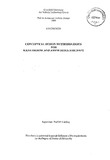JavaScript is disabled for your browser. Some features of this site may not work without it.
| dc.contributor.advisor | Fielding, John | |
| dc.contributor.author | Chicken, S. H. | |
| dc.date.accessioned | 2016-06-08T10:24:04Z | |
| dc.date.available | 2016-06-08T10:24:04Z | |
| dc.date.issued | 1999 | |
| dc.identifier.uri | http://dspace.lib.cranfield.ac.uk/handle/1826/9945 | |
| dc.description.abstract | This study is laid out in 8 self-explanatory sections. The Introduction sets the scene for the thesis by describing the reasoning behind the study, defines terms and introduces the reader to the markets for amphibious aircraft which drive the design requirements. An overall floatplane design methodology is developed. The advantages and disadvantages of the 2 practical float configurations are identified, which result in a basic configuration choice methodology. A method of initially estimating float dimensions and mass for a required displacement is developed from existing references and the aircraft and float databases. Initial float support structure design solutions are proposed based, again, on the information from the databases. A method of positioning the resultant float and structure configuration relative to the existing land-based aircraft centre of gravity is then developed using existing guidance on lateral and longitudinal water-borne static stability and the aircraft database. Guidance on the initial purchase price of floats is gained from a study of commercially available items. The changes in performance due to fitting floats to a conventional aircraft are studied along with a drag comparison study of the main configurations. The work on flyingboats develops an overall flyingboat design methodology which identifies key areas where design methods are required. These methods are developed leading to initial configuration choice methodologies based on a series of generalised mass, configuration and role classifications. Having decided on the overall configuration, tools are developed to choose the method of providing on-water lateral stability and to complete the initial sizing of that choice. A method of estimating initial planing bottom dimensions is developed along with step position and configuration. Tools to estimate the mass of flyingboat-specific items are developed including planing bottom structure and the choice of lateral stability method. Knowing the mass and configuration of the flyingboat allows spray estimation and detailed on-water static stability calculations to be completed to check the acceptability of the initial configuration and dimensions. Performance estimation methods including take-off and landing, aerodynamic drag and on-water dynamic stability are proposed. Logistic support infrastructure, safety and water loading are common to both floatplanes and flyingboats and these are discussed in a separate section, along with a method of allocating values to amphibious aircraft design attributes to measure the success of the design. The methodologies are then used to design 5 floatplanes and 5 flyingboats based on a crosssection of relevant aircraft specification types. This use of the methodologies illustrates that the concept of a linked series of tools to complete the rapid conceptual design of an amphibious aircraft has been successfully achieved. A discussion chapter summarises the key discoveries in each of then former chapters and a conclusion details how the study's aim to develop integrated conceptual design methodologies for waterborne and amphibious aircraft has been successfully achieved. The study's contribution to knowledge, which includes mass, sizing, performance and cost equations for both floatplanes and flyingboats, are also detailed. A list of further work is included which concentrates on the need for further empirical information to increase confidence in the methodologies. A comprehensive bibliography of relevant texts is included. | en_UK |
| dc.language.iso | en | en_UK |
| dc.publisher | Cranfield University | en_UK |
| dc.title | Conceptual design methodologies for waterborne and amphibious aircraft | en_UK |
| dc.type | Thesis or dissertation | en_UK |
| dc.type.qualificationlevel | Doctoral | en_UK |
| dc.type.qualificationname | PhD | en_UK |
